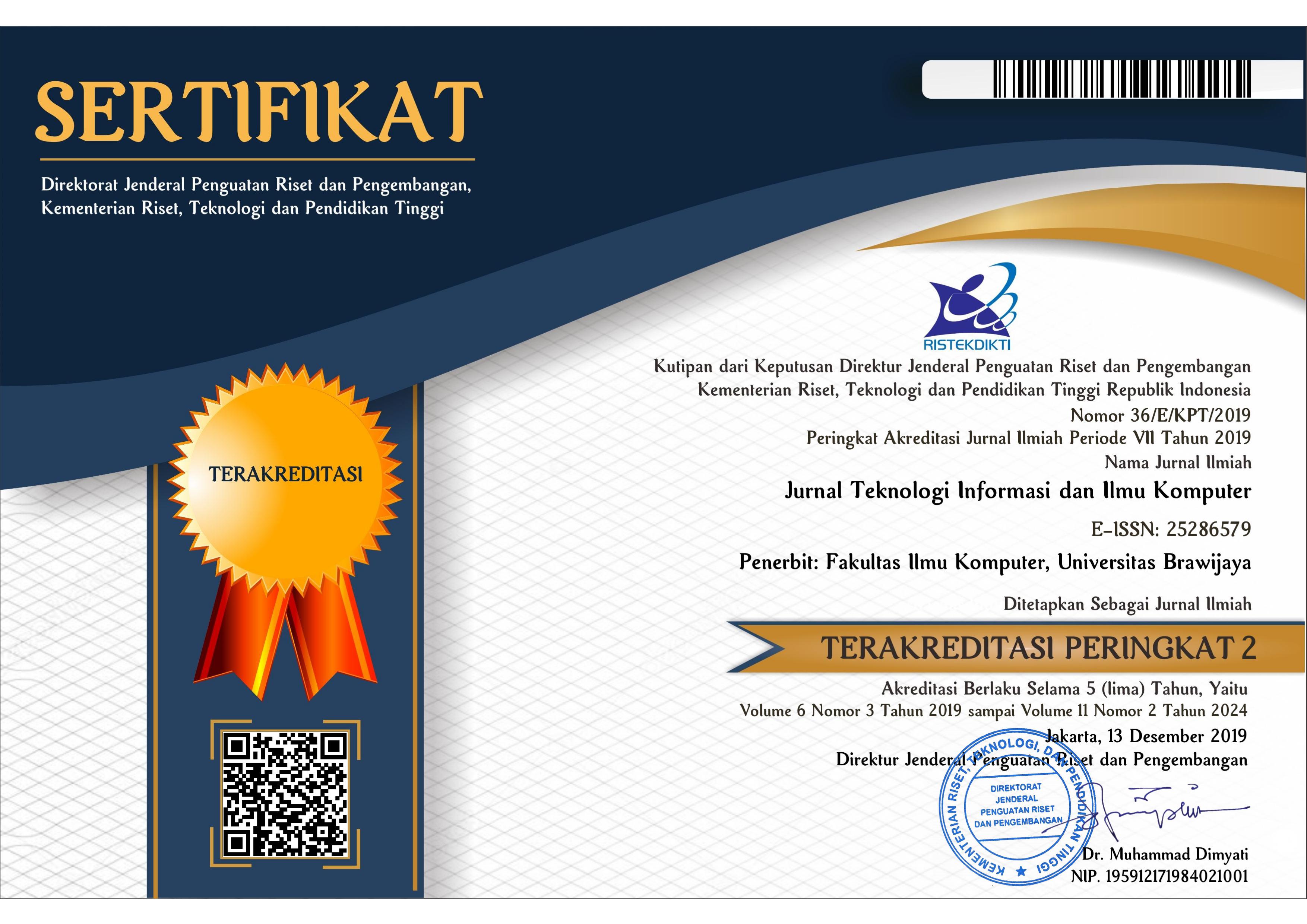Implementasi Load Balancing pada Cluster Server Berbasis Raspberry Pi Memanfaatkan Algoritma Least Connection
DOI:
https://doi.org/10.25126/jtiik.2025129452Kata Kunci:
Load Balancing, Docker , Ansible, Cluster Server, Raspberry Pi, Docker SwarmAbstrak
Keterbatasan sumber daya dalam implementasi server menjadi salah satu aspek yang perlu diperhatikan. Penggunaan Raspberry Pi, yang merupakan sebuah perangkat dengan ukuran kecil dan dapat digunakan sebagai server fisik dengan konsumsi sumber daya rendah, menjadi salah satu solusi. Namun, untuk menghindari overload pada server fisik Raspberry Pi, penggunaan cluster server sebagai pemerataan beban kerja dari satu server ke server lainnya menjadi relevan. Cluster server menggunakan Docker swarm memungkinkan pengaturan yang lebih mudah dan efisien dari banyak node dalam sebuah cluster. Pemerataan beban kerja menggunakan load balancing dengan algoritma Least Connection. Algoritma Least Connection berjalan berdasarkan antrian paling sedikit, ketika antrian di suatu node rendah, node tersebut akan menerima beban kerja baru, sehingga mencegah overload pada satu node sementara node lainnya masih memiliki kapasitas yang tersedia. Pendistribusian image ke setiap node dalam cluster dilakukan dengan menggunakan Ansible untuk memastikan pengelolaan konfigurasi yang konsisten dan otomatis di seluruh node. Secara umum, penelitian ini mengintegrasikan tiga teknologi utama, yaitu Docker untuk manajemen kontainer, Ansible untuk manajemen konfigurasi, dan load balancing dengan algoritma Least Connection. Perancangan dan implementasi penelitian difokuskan pada penerapan dan optimalisasi masing-masing teknologi ini. Hasil pengujian penelitian menunjukkan bahwa ansible efektif dalam mempermudah pengelolaan konfigurasi dan otomatisasi distribusi image di seluruh node dalam kluster. Sementara itu, load balancing dengan algoritma Least Connection berhasil membagi beban kerja secara optimal berdasarkan antrian atau koneksi terendah, yang secara signifikan meningkatkan responsivitas dan efisiensi sistem secara keseluruhan.
Abstract
Limited resources in server implementation is one aspect that needs to be considered. The use of Raspberry Pi, which is a device with a small size and can be used as a physical server with low resource consumption, is one solution. However, to avoid overloading the Raspberry Pi physical server, the use of a server cluster as an equalization of workload from one server to another becomes relevant. Cluster servers using Docker swarm allow easier and more efficient organization of many nodes in a cluster. Workload equalization uses load balancing with the Least Connection algorithm. The Least Connection algorithm runs based on the least queue, when the queue at a node is low, the node will receive a new workload, thus preventing overload on one node while other nodes still have available capacity. Image distribution to each node in the cluster is done using Ansible to ensure consistent and automated configuration management across nodes. In general, this research integrates three main technologies, namely Docker for container management, Ansible for configuration management, and load balancing with the Least Connection algorithm. The design and implementation of the research focused on the application and optimization of each of these technologies. The test results show that Ansible is effective in simplifying configuration management and automating image distribution across all nodes in the cluster. Meanwhile, load balancing with the Least Connection algorithm successfully divides the workload optimally based on the lowest queue or connection, which significantly improves overall system responsiveness and efficiency.
Downloads
Referensi
ALANKAR, B., SHARMA, G., KAUR, H., VALVERDE, R. & CHANG, V., 2020. Experimental setup for investigating the efficient load balancing algorithms on virtual cloud. Sensors, 2024, p.7342. Available at: https://doi.org/10.3390/s20247342 [Diakses 25 September 2023]
ROHADI, E., AMALIA, A., PRASETYO, A., RAHMAT, M.F., SETIAWAN, A. & SIRADJUDDIN, I., 2020. Cluster implementation on mini Raspberry Pi computers using Round Robin Algorithm. Journal of Physics, 1450. Available at: https://doi.org/10.1088/1742-6596/1450/1/012068 [Diakses 25 September 2023].
ROHADI, E., PRASETYO, A. & RAHMAT, M.F., 2019. Implementasi klaster komputer mini RaspberryPi metode load balancing menggunakan algoritma Round Robin. Jurnal Informatika Polinema, 5(3), p.132. Available at: https://doi.org/10.33795/jip.v5i3.248 [Diakses 25 September 2023].
SUJANA, A.P., 2019. Implementasi cluster server pada Raspberry Pi dengan menggunakan metode load balancing. Komputika : Jurnal Sistem Komputer, 8(1), pp.37–43. Available at: https://doi.org/10.34010/komputika.v8i1.1623 [Diakses 25 September 2023].
HOWARD. “A Complete Guide to Server Cluster | FS Community.” Knowledge, 22 Mar. 2024, community.fs.com/article/a-complete-guide-to-server-clusters.html.
LEE, RICH, & BINGCHIANG JENG. “Load-Balancing Tactics in Cloud.” IEEE Xplore, 1 Oct. 2011, ieeexplore.ieee.org/document/6079471. [Accessed 6 Jan. 2023].
IBM, 2024. Introduction: Clusters. [online] Available at: https://www.ibm.com/docs/en/was-nd/8.5.5?topic=servers-introduction-clusters [Diakses 1 Februari 2024].
CITRIX 2024. Least Connection Method | NetScaler 14.1. [online] docs.netscaler.com. Available at: https://docs.netscaler.com/en-us/citrix-adc/current-release/load-balancing/load-balancing-customizing-algorithms/leastconnection-method.html [Diakses 10 Maret 2024].
AWS 2023. Apa Itu Docker? | AWS. [online] Amazon Web Services, Inc. Available at: https://aws.amazon.com/id/docker/.
DOCKER INC., 2023. Docker Overview | Docker Documentation. [Online] Available at: https://docs.docker.com/get-started/overview/ [Accessed 25 Maret 2024].
ANSIBLE, 2023. Getting started with Ansible - Ansible Documentation. [Online] Available at: https://docs.ansible.com/ansible/latest/ [Accessed 10 Juni 2024
DOCKER, 2019. Swarm mode overview. [online] Docker Documentation. Available at: https://docs.docker.com/engine/swarm/ [Accessed 10 Juni 2024].
NAIK, N. 2016. Building a Virtual System of Systems Using Docker swarm in Multiple Clouds. [online] IEEE Xplore. doi:https://doi.org/10.1109/SysEng.2016.7753148.
SINGH, N.K., THAKUR, S., CHAURASIYA, H. AND NAGDEV, H. 2015. Automated Provisioning of Application in IAAS Cloud Using Ansible Configuration Management. [online] IEEE Xplore. doi:https://doi.org/10.1109/NGCT.2015.7375087.
MA, C. AND CHI, Y. 2022. Evaluation Test and Improvement of Load Balancing Algorithms of Nginx. IEEE Access, 10, pp.14311–14324. doi:https://doi.org/10.1109/access.2022.3146422.
AHMED, A. AND PIERRE, G. 2020. Docker-pi: Docker Container Deployment in Fog Computing Infrastructures. International Journal of Cloud Computing, 9(1), p.6. doi:https://doi.org/10.1504/ijcc.2020.105885.
Unduhan
Diterbitkan
Terbitan
Bagian
Lisensi
Hak Cipta (c) 2025 Jurnal Teknologi Informasi dan Ilmu Komputer

Artikel ini berlisensiCreative Commons Attribution-ShareAlike 4.0 International License.

Artikel ini berlisensi Creative Common Attribution-ShareAlike 4.0 International (CC BY-SA 4.0)
Penulis yang menerbitkan di jurnal ini menyetujui ketentuan berikut:
- Penulis menyimpan hak cipta dan memberikan jurnal hak penerbitan pertama naskah secara simultan dengan lisensi di bawah Creative Common Attribution-ShareAlike 4.0 International (CC BY-SA 4.0) yang mengizinkan orang lain untuk berbagi pekerjaan dengan sebuah pernyataan kepenulisan pekerjaan dan penerbitan awal di jurnal ini.
- Penulis bisa memasukkan ke dalam penyusunan kontraktual tambahan terpisah untuk distribusi non ekslusif versi kaya terbitan jurnal (contoh: mempostingnya ke repositori institusional atau menerbitkannya dalam sebuah buku), dengan pengakuan penerbitan awalnya di jurnal ini.
- Penulis diizinkan dan didorong untuk mem-posting karya mereka online (contoh: di repositori institusional atau di website mereka) sebelum dan selama proses penyerahan, karena dapat mengarahkan ke pertukaran produktif, seperti halnya sitiran yang lebih awal dan lebih hebat dari karya yang diterbitkan. (Lihat Efek Akses Terbuka).















